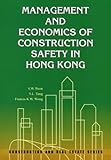| Title: | Management and Economics of Construction Safety in Hong Kong |
| Categories: | Construction |
| Authors: | Sun Wah Poon, S. L. Tang, Francis K. W. Wong |
| ISBN-10(13): | 9622099068 |
| Publisher: | Hong Kong University Press |
| Publication date: | 2008-07-15 |
| Number of pages: | 180 |
| Language: | English |
| Picture: |

|
| Review: |
Many years ago I reviewed research proposals for investigating safety in Hong Kong. The statistics then were not one that anyone could have taken any satisfaction from. The situation has improved but there is still a long way to go. Consequently this book makes a valuable contribution to the campaign of promoting safety in construction in Hong Kong. The opening Chapter reviews safety statistics in five Asian countries or regions namely Japan, South Korea, Singapore, Taiwan and Hong Kong. The authors observe the effect of the measures that have been implemented in Hong Kong leading to the improvement in their safety record. In the regions studied Japan was the best performer. In Hong Kong construction accidents account for 18.9% of all industrial accidents and was the worst performing region of those studied by the authors. Chapter 2 reviews research studies conducted in Hong Kong, Mainland China and the UK from which the authors try to draw out solutions to the problems of implementing safety programmes. Chapter 3 reports on the regulatory requirements and on a survey of companies� difficulties with these. Chapter 4 presents an update on the safety related legislation in Hong Kong. Chapter 5 promotes the use of safety auditing as a means of improving practices in preventing accidents. Chapter 6 gives an overview to accident investigation and the reporting required. Chapter 7 addresses the role of site supervisors in the safety management process. Chapter 8 tackles the financial cost of accidents and estimates safety investment to add 0.8% to building cost. Chapter 9 and Chapter 10 are focussed on the social cost and human suffering. The book is useful to both students and practitioners of safety management particularly in the Hong Kong context. It is interesting that safety costs and consequences come in the last two chapters. Should these social and human costs not have come first. It seems to me that safety management in some other countries has moved on from evaluating the cost of safety and trying to justify that cost by the social costs and human suffering. In many places we are in an environment where the target is zero-accidents, as it was on the New Hong Kong Airport project. In many places, including Hong Kong you pass sites that declare on public notice broads how many man hours have passed since the last reportable accident. Companies are given rewards for 1,000,000 man hours without accidents, the culture of only targeting zero accidents is well established and I believe this is true of Hong Kong. This is a campaigning book, campaigning for improved safety. Its campaign should have been more ambitious setting the highest challenges, such as targeting zero accidents. This would mean not merely satisfying the regulations that exist but going even further. Should we actually aim for anything less? Ronald McCaffer Loughborough University |



